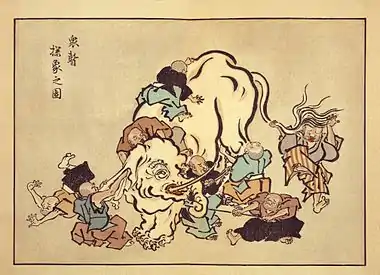Hanabusa Itchō
Hanabusa Itchō (英 一蝶, 1652 – February 7, 1724) was a Japanese painter, calligrapher, and haiku poet. He originally trained in the Kanō style, under Kanō Yasunobu, but ultimately rejected that style and became a literati (bunjin). He was also known as Hishikawa Waō and by a number of other art-names.


Biography
Born in Kyoto and the son of a physician, he was originally named Taga Shinkō. He studied Kanō painting, but soon abandoned the school and his master to form his own style, which would come to be known as the Hanabusa school.
He was exiled in 1698, for parodying one of the shōgun's concubines in painting, to the island of Miyake-jima; he would not return until 1710. That year, in Edo, the artist would formally take the name Hanabusa Itchō.
Most of his paintings depicted typical urban life in Edo, and were approached from the perspective of a literati painter. His style, in-between the Kanō and ukiyo-e, is said to have been "more poetic and less formalistic than the Kanō school, and typical of the "bourgeois" spirit of the Genroku period".[1]
Hanabusa was the master of the later painter Sawaki Suushi.[2]
Hanabusa studied poetry under the master Matsuo Bashō, and is said to have been an excellent calligrapher as well.
His work is held in several institutions worldwide, including the Museum of Fine Arts Boston,[3][4][5] the Philadelphia Museum of Art,[6] the Los Angeles County Museum of Art,[7] the Smithsonian Libraries,[8] the Israel Museum ,[9] the Suntory Museum of Art,[10] the Seattle Art Museum,[11] the Museum of Cultural History Oslo,[12] the University of Michigan Museum of Art,[13] the Brooklyn Museum,[14] the Minneapolis Institute of Art,[15] the National Museum of Korea,[16] and the British Museum.[17]
See also
- Hanabusa Itchō II – son and pupil of Itchō
- nanga – "literati painting"
Notes
- Frederic, Louis (2002). "Japan Encyclopedia." Cambridge, Massachusetts: Harvard University Press.
- http://pinktentacle.com/2008/02/edo-period-monster-paintings-by-sawaki-suushi/
- "The Death of the Historical Buddha". collections.mfa.org. Retrieved 2021-02-03.
- Voon, Claire (2016-08-19). "MFA Boston Publicly Conserves 18th-Century Buddhist Painting Masterpiece". Hyperallergic. Retrieved 2021-02-03.
- "An Ancient Japanese Scroll Gets Pieced Back Together | Conservation Lab". www.vice.com. Retrieved 2021-02-03.
- "Philadelphia Museum of Art - Collections Object : Children at Play". www.philamuseum.org. Retrieved 2021-02-03.
- "Otafuku | LACMA Collections". collections.lacma.org. Retrieved 2021-02-03.
- Hanabusa, Itchō. "Gunchō gaei". library.si.edu. Retrieved 2021-02-03.
- "Hanabusa Itcho, Japan, 1652-1724 | The Israel Museum, Jerusalem". www.imj.org.il. Retrieved 2021-02-03.
- "Rural genre scenes: Collection Database". SUNTORY MUSEUM of ART. Retrieved 2021-02-03.
- "Works – Hanabusa Itcho – Artists – eMuseum". art.seattleartmuseum.org. Retrieved 2021-02-03.
- Phone, Visiting address Museum of Cultural HistoryFrederiks gate 2 0164 Oslo Mail address P. O. Box 6762 St Olavs plass 0130 Oslo; fax. "Hanabusa Itcho - Museum of Cultural History". www.khm.uio.no. Retrieved 2021-02-03.
- "Exchange: Mt. Fuji in Autumn". exchange.umma.umich.edu. Retrieved 2021-02-03.
- "Brooklyn Museum". www.brooklynmuseum.org. Retrieved 2021-02-03.
- "Parinirvana of Sakyamuni, the Historical Buddha, Hanabusa Itchō ^ Minneapolis Institute of Art". collections.artsmia.org. Retrieved 2021-02-03.
- "Genre Painting | Collection Database" Check
|url=value (help). NATIONAL MUSEUM OF KOREA. Retrieved 2021-02-03. - "Collections Online | British Museum". www.britishmuseum.org. Retrieved 2021-02-03.
References
- Lane, Richard. (1978). Images from the Floating World, The Japanese Print. Oxford: Oxford University Press. ISBN 9780192114471; OCLC 5246796
External links
| Wikimedia Commons has media related to Hanabusa Itcho. |
- Bridge of dreams: the Mary Griggs Burke collection of Japanese art, a catalog from The Metropolitan Museum of Art Libraries (fully available online as PDF), which contains material on Hanabusa Itchō (see index)
- Short biography of Hanabusa Itcho - Jyuluck-Do Corporation